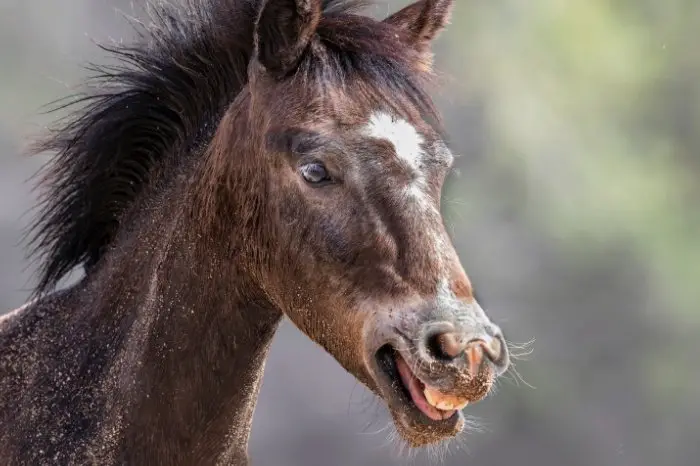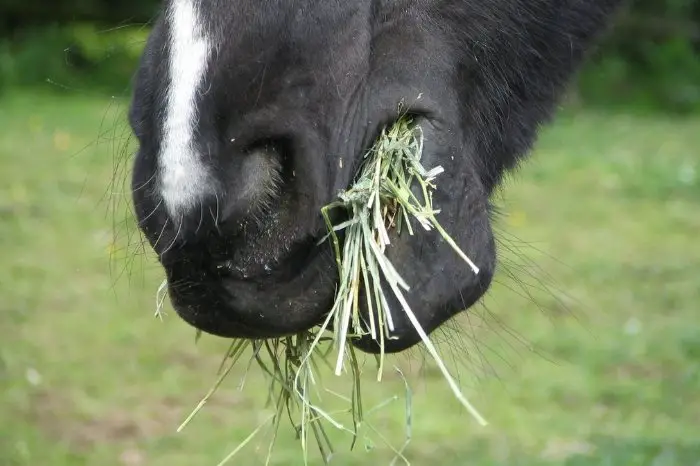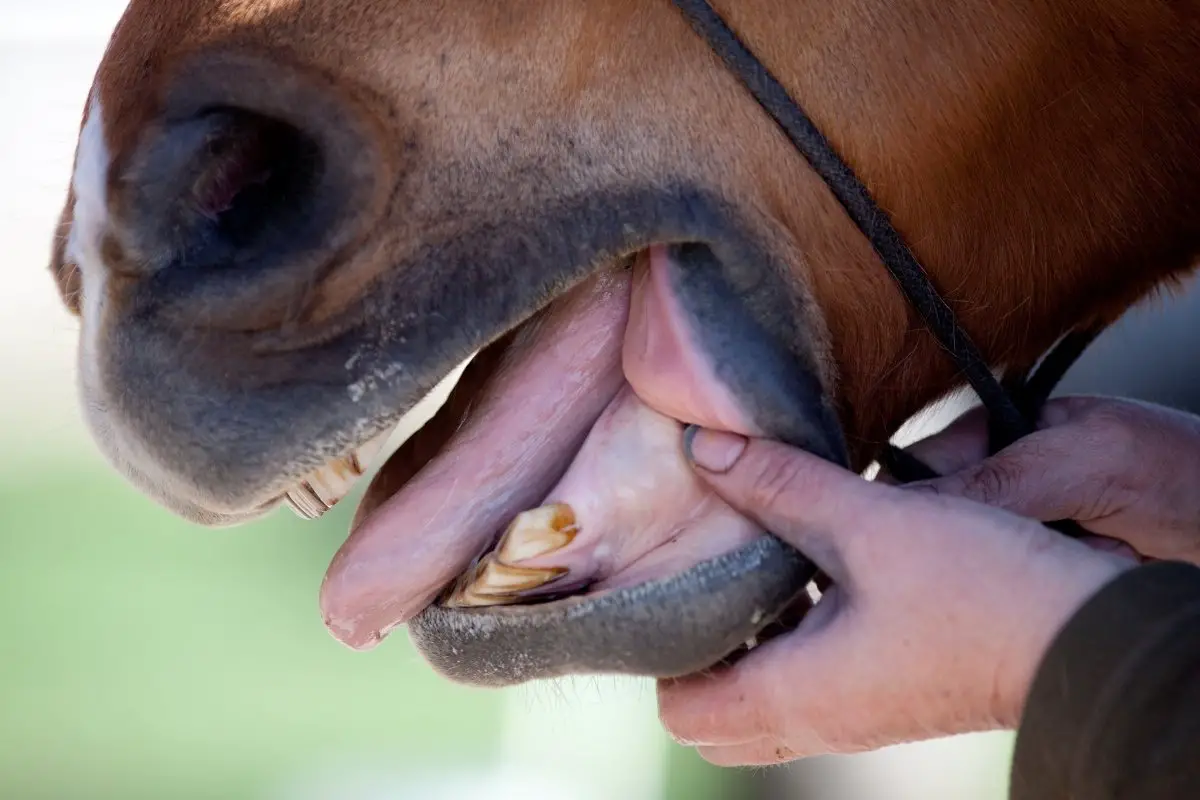Last Updated on February 14, 2022
Horses are uniquely adapted in many ways to enable them to consume large amounts of grass and hay. By understanding equine tooth anatomy we can learn to keep our horse’s teeth in the best possible shape. Let’s find out more!
Equine Dental Anatomy Explained
Horses are quite unusual in their equine tooth anatomy, with some interesting and clever adaptations in the structure of their teeth. The reason for this is the primary diet of the horse – they need to spend many hours each day eating and chewing grass and hay. To do this, horses have different kinds of teeth with different functions.
What Kind Of Teeth Do Horses Have?
The horse has four distinctive types of teeth – incisors, canines, premolars, and molars.
-
Incisors
These are the teeth at the front of the mouth, that we can see if we lift the lips of the horse. They are small, sharp teeth, used to grab and tear food such as grass.
-
Canine Teeth
Not all horses have canine teeth, and they are more common in male horses than female horses. In ancient times, these pointed teeth would have been used as a weapon in fights, or when the horse was trying to defend itself against predators. They have no useful function in the modern domesticated horse.
-
Premolars And Molars
Further back in the mouth are the premolars, that sit in a tightly packed line with the molars. Together, these teeth make a formidable grinding surface, turning tough grass and hay into a soft ball that is easy to swallow.
Check Out: Red And Black Horse Base Coat Colors Explained
What Are Wolf Teeth In A Horse?
Wolf teeth are tiny teeth that sit just in front of the first premolars. Not all horses have wolf teeth, and they have no useful purpose. Wolf teeth are sometimes removed as they can cause problems when the horse is ridden, due to interference with the action of the bit in the horses mouth.
Horse Teeth – Their Form and Function
How Do Horses Teeth Grow?
The chewing action of the horse will very gradually wear away the grinding surface of the molars and premolars, causing the tooth to become shorter. It is estimated that the molar teeth wear away at a rate of 2-3mm per year.
To prevent the tooth wearing away altogether, the cheek teeth of a horse erupt very slowly, over the lifetime of the horse. However, the tooth is not growing – the horse is born with all the teeth present in the skull! These are not fully formed at birth, and will gradually develop over the first seven years of the horses life.
This means that if you were to look inside the skull of a young horse, you would see very long cheek teeth that extend right into the lower jaw and upper sinuses. An old horse would have very short teeth, or perhaps none at all if they have worn away completely.
Read more about Leopard Appaloosa Spotted Horses Explained
Young Equine Teeth Anatomy
Young horses, like humans, also have ‘baby teeth’; these are called deciduous teeth. These teeth will fall out over time, as the adult permanent teeth push themselves through.
A young horse will have 24 deciduous teeth. It will have 12 incisors and 12 premolars, but no molar teeth. The deciduous teeth normally appear within two weeks of the birth of the foal.

Adult Horse Teeth Anatomy
As the foal grows older, these baby teeth will be replaced by permanent teeth. This is a very slow process that starts when the foal is 6 months old, but may not be fully complete until the horse is 5 years old.
The first adult teeth to start erupting are the wolf teeth, if they are present at all. This happens when the foal is 6 months old. Next the molar teeth will come through, followed by the premolars and incisors. Last of all to erupt are the canine teeth.
An adult horse will have 12 incisors, 12 premolars, and 12 molars. A male horse will normally have canine teeth, giving it a total of 40 teeth.
How Do Horses Chew Their Food?
The fascinating thing about equine tooth anatomy is their ability to chew huge quantities of tough forage. This is because the structure of the molar and premolar teeth is uniquely adapted togrind up tough grasses and hay.
The grinding surface of a horse’s cheek teeth is created by a line of molars and premolars that are tightly packed together. This gives a flat, abrasive surface, which can be used to pulverize food by grinding against the opposing line of teeth. To do this, the horse moves its jaw in a circular motion, aided by the powerful jaw muscles.
To maximize the grinding abilities of the cheek teeth, they contain a large amount of an incredibly hard substance called enamel. This enamel is woven through the tooth, to give a rough, ridged, and very efficient grinding surface.

Why Do Horses Have Teeth Problems?
There are many things that can go wrong with equine tooth anatomy, and most of these are caused by the way we keep our domesticated horses. The chewing action of the horse is designed to wear down the surface of the teeth evenly, and the horse needs to consume large amounts of forage to do this. When we swap rough forage for pelleted processed feeds or softer grasses, the horse does not need to chew as much.
This means that the teeth do not wear down evenly, and sharp points and other abnormalities can develop. It is essential that all horses have a dental check at least once per year, to see if any sharp points or uneven teeth need to be floated.
Summary
So, as we have learned, equine tooth anatomy is uniquely adapted to enable them to consume large quantities of grass and hay. They have large, strong teeth and powerful jaws, that can grind food and make it easier to digest. The teeth of a horse are long and erupt slowly throughout its lifetime, to compensate for wearing away of the grinding surface of the tooth.
We’d love to hear your thoughts on equine tooth anatomy! Have you had to deal with a dental problem in your horse? Or maybe you have questions about horse teeth anatomy? Leave a comment below and we’ll get back to you!

Kate Chalmers is a qualified veterinary nurse who has specialized in horse care for the vast majority of her career. She has been around horses since she was a child, starting out riding ponies and helping out at the local stables before going on to college to study Horse Care & Management. She has backed and trained many horses during her lifetime and competed in various equestrian sports at different levels.
After Kate qualified as a veterinary nurse, she provided nursing care to the patients of a large equine veterinary hospital for many years. She then went on to teach horse care and veterinary nursing at one of the top colleges in the country. This has led to an in-depth knowledge of the care needs of horses and their various medical ailments, as well as a life-long passion for educating horse owners on how to provide the best possible care for their four-legged friends.
Kate Chalmers BSc (Hons) CVN, Dip AVN (Equine) Dip HE CVN EVN VN A1 PGCE


